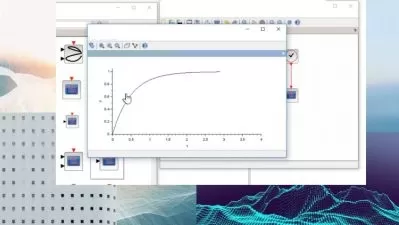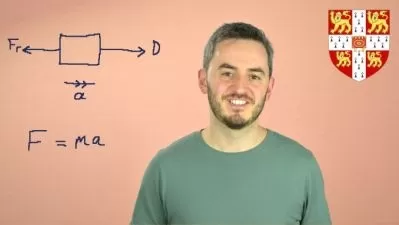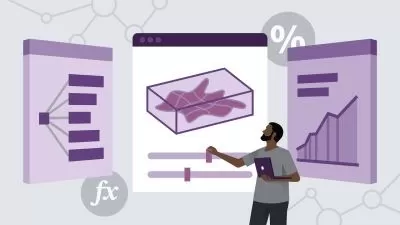Introduction to Engineering Computing with MatLab
Andrew Kopnoff
4:00:17
Description
Part 1
What You'll Learn?
- Basics of engineering computing with MatLab
- What does contemporary calculator look like, and what functionality we want of it?
- Generic algorithms (steps to take) to solve an unfamiliar engineering problem
- Setting up MatLab's interface
- Simple arithmetics in MatLab
- Using variables
- m-files
- m-files vs. live scripts.
- Improving the legibility of the code
- Manipulating algebraic expressions symbolically
- Precision in MatLab
- Making practical sense of arrays and matrices
Who is this for?
What You Need to Know?
More details
DescriptionThis course is designed for people who want to step in to the field of using computers to solve engineering problems. But, more importantly, for people who seek to expand their thinking frontiers and thus to acquire the most valuable personal asset in engineering.
The course serves as a precursor to further studies of MatLab and engineering computing, and I strongly advise you do it first before embarking on more advanced topics.
Engineering today is an extremely broad term that encompasses an enormous span of fields from populational genetics to quantum mechanics. And here I imply it in this broad sense (not in the sense of “the guys that dig some dirt and wear orange hats and vestsâ€).
This course concerns itself with engineering computing also known as scientific computing, and with MatLab as a specific tool for accomplishing this.
It is very important to point that MatLab is only one of such tools. The natural question to ask then is as follows, “Is it the best tool for the job?†The other reasonable question to ask is, “Can’t we just use a conventional tabletop calculator – what advantages do tools like MatLab provide?†Until you have absolute clarity with the above questions there is no point to proceed any further, for you will end up with a disjointed information set that can hardly be called a skill.
Let me clarify matters using some common misconceptions.
“You will learn MatLab programming in this course, and this is what is expected of you – to do programming in MatLabâ€. While the term “programming†is quite accurate when applied to MatLab (you do use a BASIC-like language to tell the machine what to do), you need not forget that it is an engineering problem that you are trying to solve. And it is not as much the knowledge of programming that is going to be decisive as a clear plan of action. This plan of action, above all, requires engineering wit and not programming skills.
“There are plenty of other courses out there that teach you some baby steps in MatLab, but the industry wants you to be able to do real stuff like apply the convergence properties of the Nelder-Mead simplex method in low dimensionsâ€. This is not the case in Engineering where the knowledge of a particular optimisation method or any other mathematical abstraction, or the fact that you can plot a 3-D graph or code a two-way user interface in MatLab is of virtually no use at all. What is needed and is indeed expected of an engineer is to design a plan of action (the computational algorithm), find suitable mathematical methods, and automate the entire task using tools like MatLab. In plain words, the most valued and sought-for skill is a multi-dimensional and highly non-linear way of thinking.
This is why, by far the main goal of this course, as well as all my other courses, is to instil a habit of asking “Why things are the way they are?â€
You will find more information if you watch the course introduction lectures.
Who this course is for:
- General public with interest in engineering
This course is designed for people who want to step in to the field of using computers to solve engineering problems. But, more importantly, for people who seek to expand their thinking frontiers and thus to acquire the most valuable personal asset in engineering.
The course serves as a precursor to further studies of MatLab and engineering computing, and I strongly advise you do it first before embarking on more advanced topics.
Engineering today is an extremely broad term that encompasses an enormous span of fields from populational genetics to quantum mechanics. And here I imply it in this broad sense (not in the sense of “the guys that dig some dirt and wear orange hats and vestsâ€).
This course concerns itself with engineering computing also known as scientific computing, and with MatLab as a specific tool for accomplishing this.
It is very important to point that MatLab is only one of such tools. The natural question to ask then is as follows, “Is it the best tool for the job?†The other reasonable question to ask is, “Can’t we just use a conventional tabletop calculator – what advantages do tools like MatLab provide?†Until you have absolute clarity with the above questions there is no point to proceed any further, for you will end up with a disjointed information set that can hardly be called a skill.
Let me clarify matters using some common misconceptions.
“You will learn MatLab programming in this course, and this is what is expected of you – to do programming in MatLabâ€. While the term “programming†is quite accurate when applied to MatLab (you do use a BASIC-like language to tell the machine what to do), you need not forget that it is an engineering problem that you are trying to solve. And it is not as much the knowledge of programming that is going to be decisive as a clear plan of action. This plan of action, above all, requires engineering wit and not programming skills.
“There are plenty of other courses out there that teach you some baby steps in MatLab, but the industry wants you to be able to do real stuff like apply the convergence properties of the Nelder-Mead simplex method in low dimensionsâ€. This is not the case in Engineering where the knowledge of a particular optimisation method or any other mathematical abstraction, or the fact that you can plot a 3-D graph or code a two-way user interface in MatLab is of virtually no use at all. What is needed and is indeed expected of an engineer is to design a plan of action (the computational algorithm), find suitable mathematical methods, and automate the entire task using tools like MatLab. In plain words, the most valued and sought-for skill is a multi-dimensional and highly non-linear way of thinking.
This is why, by far the main goal of this course, as well as all my other courses, is to instil a habit of asking “Why things are the way they are?â€
You will find more information if you watch the course introduction lectures.
Who this course is for:
- General public with interest in engineering
User Reviews
Rating
Andrew Kopnoff
Instructor's Courses
Udemy
View courses Udemy- language english
- Training sessions 27
- duration 4:00:17
- Release Date 2023/12/25

















